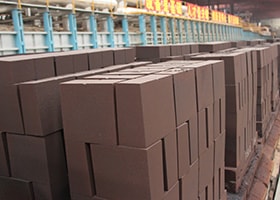- Mob/WhatsApp/Skype/Whchat: +86 18103817770
- E-mail: info@magnesiumbrick.com
Product introduction of magnesia chrome brick
Generally speaking, the magnesia chrome brick generally refers to the fired ordinary magnesia chrome brick, also known as silicate bonded magnesia chrome brick, or magnesia chrome brick for short. At present, according to different production methods, magnesia chrome bricks can be divided into ordinary bricks, direct bonding bricks, electric fusion rebinding bricks and salt impregnated magnesia chrome bricks.
Advantages of magnesia chrome brick
Anti peeling
Good thermal stability
Magnesia chrome brick has high fire resistance
Strong corrosion resistance to alkaline slag
Application of magnesia chrome brick
Magnesia chrome bricks are mainly used for cement rotary kilns, regenerators of glass kilns, lining of steelmaking furnaces, permanent layer of refining ladles, non-ferrous metallurgical furnaces, lime kilns, iron mixing furnaces and lining of refractory high-temperature kilns. The high temperature part of the ultra-high power electric furnace wall is made of fused cast magnesia chrome bricks, the high erosion area of the external refining furnace is made of synthetic materials, and the high erosion area of the nonferrous metal flash smelting furnace is made of fused cast magnesia chrome bricks and synthetic materials.
More relevant refractory products: Ceramic fiber tube
Parameters of magnesia chrome brick
| Model | MGe6 | MGe8 | MGe12 | MGe16 | DMGe4 | DMGe8 | DMGe12 | DMGe16 |
| MgO % | 80 | 72 | 70 | 65 | 85 | 77 | 74 | 69 |
| Cr2O3 % | 7 | 10 | 13 | 17 | 5.5 | 9.1 | 14 | 18 |
| CaO % | 1.2 | 1.2 | 1.2 | 1.2 | 1.1 | 1.4 | 1.2 | 1.2 |
| SiO2 % | 3.4 | 4 | 4 | 4.2 | 1.3 | 1.2 | 1.2 | 1.5 |
| Al2O3 % | 4.5 | 6.5 | 6 | 6 | 3.5 | 4 | 3.5 | 4.5 |
| Fe2O3 % | 4 | 4.8 | 5.5 | 6.5 | 3 | 6.4 | 5 | 5.7 |
| Apparent Porosity % | 17 | 18 | 18 | 18 | 18 | 18 | 18 | 18 |
| Bulk Density g/cm3 | 3 | 3 | 3.02 | 3.05 | 3.02 | 3.04 | 3.06 | 3.08 |
| Cold Crushing Strength Mpa | 55 | 55 | 55 | 50 | 50 | 50 | 55 | 55 |
| Refractoriness Under Load °C | 1600 | 1600 | 1600 | 1600 | 1700 | 1700 | 1700 | 1700 |
| Thermal expansion % 1000°C | / | / | / | / | 1 | 1 | 1 | 0.9 |
| Thermal expansion % 1600°C | / | / | / | / | 1.8 | 1.8 | 1.8 | 1.6 |
